A way of producing emission-free, safe and practically inexhaustible fusion energy has already been found. However, wider use of fusion reaction to produce energy still requires years of research before large-scale commercial fusion energy production can begin.
Exploration of the renewable energy of the future – fusion energy – began in the 1950s. For example, Europe's most famous fusion device, JET (Joint European Torus), achieved the controlled release of fusion power of one megawatt in two seconds in 1991, but at the same time consumed many times more energy, 15 megawatts.
Currently under construction through international cooperation in Cadarache, France, the ITER (International Thermonuclear Experimental Reactor) is hoped to enable longer plasmas and long-term pulses of fusion power with a ten-fold return on energy.
- In the ITER project we are seeking to increase fusion energy production by an order of magnitude. In fact, more than twenty research reactors are already in operation around the world, but they are mainly small-scale devices. Experimenting with the research reactors has shown that a lot more energy is required to achieve a stable fusion reaction, says VTT Principal Scientist Timo Määttä.
Climate change is forcing us to drastically reduce our carbon dioxide emissions. One way to do that is to harness the energy of fusion. Määttä says that industrial fusion energy such as solar energy is powered by a fusion reaction.
- The traditional way of producing nuclear power is based on a fission reaction process, in which the nucleus of an atom splits into smaller, lighter nuclei. In a fusion process, two lighter atomic nuclei combine to form a heavier nucleus, while releasing energy.

ITER – the world's most complex machine
ITER is designed to be the first-ever net energy reactor that will produce 500 MW of fusion power for 50 MW of injected heating power. To give an idea of the massive scale of the experimental facility, the heart of the fusion reactor, Tokamak, weighs almost as much as three Eiffel towers.
Määttä says that if the experimental facility under construction is able to reach its full potential, it will help solve the energy crisis threatening the future of humankind.
- Fission reaction is based on uranium, which is a depleting resource, whereas the sea is practically an endless source of the deuterium needed to power fusion reactions.
The EU Commission has set the goal of commencing the transmission of fusion energy to electricity grids by 2050.
- Interest in fusion energy is understandable, because fusion does not emit greenhouse gases or produce high-activity, long-lived nuclear waste like power plants based on nuclear fission. Although the fusion reaction is also a nuclear process, the reactor's materials resulting from the process do not need to be stored for tens or hundreds of thousands of years like those generated by the fission process, says Määttä.
With the fusion process, it takes 50-100 years for the radiation to decrease to a safe level. Furthermore, fusion power does not cause the types of dangerous situations or nuclear catastrophes that nuclear power plants can.
- If something goes wrong with the fusion process, the reactor simply shuts down, Määttä explains.
High tech designed by Finnish researchers
The non-fusion tests of ITER are scheduled to begin in the late 2020s, and commissioning of the reactor in 2035. Even after commissioning, the reactor will be a research reactor and the power it produces will not be transmitted to the electricity grid. The technology of the fusion reactor has proven to be too complex for commencing the commercial production of fusion energy.
According to Määttä, the scalability of fusion technology and the subsequent commercialisation of fusion energy is hampered by the difficulties faced by researchers when trying to secure funding for their research projects, the reason for this being the slow progress and long time spans of the projects. One of the challenges with the reactor is keeping the plasma stable and finding materials that can withstand the reactor's extremely high temperatures.
- These are only some of the research projects in which VTT has been an active participant, says Määttä.
Around 150 researchers in different research institutes and universities in Finland are participating in international fusion research. Despite being a small country, Finland's fusion energy expertise is valued in the sector.
- Finland's focus has been on plasma containment, suitable materials, challenging steel structures and the development of remote control technology for maintenance. Finland's expertise is not only applied in actual projects for delivering fusion reactors, but also in other nuclear energy sector and industrial sector projects, Määttä adds.
According to Määttä, robotics is essential for ITER because it enables, among others, performing the necessary maintenance, inspection and repair tasks necessary under challenging conditions to ensure that the experimental reactor functions properly. Even though the fusion reactor is shut down during maintenance, near the divertor cassettes at the core of the reactor, the temperature is a hundred degrees and the radiation levels are too high for a human to go and do any maintenance work inside the reactor.
Together with Tampere University (former Tampere University of Technology), VTT has succeeded in developing new technology that enables changing the divertor cassettes collecting impurities in the ITER with a remote-controlled cart that moves on a gear-wheel system and has actuators operated with water hydraulics.
- Changing these nine-tonne divertor cassettes has already been successfully tested at the VTT research facility in Tampere. The 'Divertor Test Platform' (i.e. the DTP2 research environment) has a full-scale model of the bottom of the fusion reactor. The test platform itself is about 20 metres long and weighs about 65 tonnes. In addition to developing a means of changing the divertor cassettes, VTT is also designing a remotely operated connector that can hold more than a hundred cables for the diagnostics system. Its reliability is also very important for the research and for the functionality of the facility.
The race is on in international fusion research
All the world's political giants are involved in the ITER project: China, Europe, India, Japan, Russia, South Korea, and the United States. In 2018, China decided to start developing a next-generation reactor, its own successor to ITER. A lot of resources will be invested in the project.
- China is seeking to learn from ITER and attempting to develop a next-generation industrial fusion reactor of its own shortly after the ITER project. China probably needs fusion energy the most, because the country's coal-fired power stations will be retired in about 30 years although its energy consumption keeps increasing along with the rising standard of living.
Määttä says that the next step after ITER will be Europe's first machine for producing fusion-based electricity, DEMO, which is scheduled for completion in the 2050s, if the research progresses as planned.
According to Määttä, before the deployment of DEMO, fusion reaction technology must be simplified a great deal from the current Tokamak of ITER.
Määttä also says that Finnish industry especially should start playing a more active role in the development of fusion power technology. Otherwise, we risk missing out on the development of high tech solutions and the resulting increase in know-how. The current trend in Finland is a decrease in public funds allocated to fusion and Big Science research.
- We need to get the Finnish industry more excited about fusion power. On the other hand, players such as Business Finland no longer invest as much as they used to in fusion research. Unless action is taken soon, Finnish researchers and fusion experts will be fewer in the future and/or start moving to other countries or areas of research.
There is a lot of potential in fusion energy, and the results of fusion research have continuously improved in Finland.
- Because of the fusion reactor's high levels of energy and thermal power, in addition to electricity, fusion could also be harnessed for producing district heat in the future. District heat, of course, could be used to heat water and for delivering hot water and steam to the industry, Määttä concludes.






